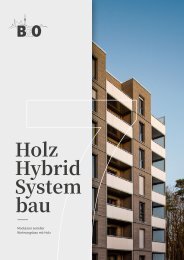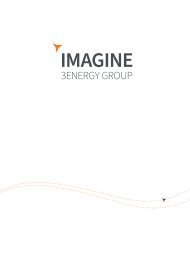Rubolab Broschüre Magnetschwebewaage
Produktbroschüre für eine Magnetschwebewaage der Firma RUBOLAB.
Produktbroschüre für eine Magnetschwebewaage der Firma RUBOLAB.
Create successful ePaper yourself
Turn your PDF publications into a flip-book with our unique Google optimized e-Paper software.
RuboSORP
Accurately determining the mass of lightweight<br />
samples is very important in many<br />
fields of research. In order to accomplish<br />
this, high-resolution analytical balances are<br />
an integral piece of equipment. Additionally,<br />
many technically relevant processes occur<br />
under technically demanding conditions<br />
such as high pressure, extreme temperatures,<br />
and aggressive or toxic atmospheres.<br />
Commercially available analytical balances<br />
cannot be used under these conditions.<br />
Therefore, the technology of the Magnetic<br />
Suspension Balance has been developed.<br />
RuboSORP’s Magnetic Suspension Balance<br />
technology offers the unique possibility of<br />
high-quality analysis under even the most<br />
extreme metrological conditions.<br />
1
Measurement<br />
Principle<br />
Magnetic Suspension Balance technology allows for high resolution mass determination under high<br />
pressure and high temperature conditions by utilizing resistant measurement cells. An industrial microbalance<br />
is located outside of the cell. Thanks to contactless magnetic suspension coupling, mass changes<br />
within the pressurized measurement cell can be determined.<br />
Microbalance<br />
Magnetic System<br />
Position Sensor for<br />
Leviation State Controlling<br />
Gas Inlet<br />
Measurement Object 2<br />
Measurement Object 1<br />
Gas Outlet<br />
T<br />
2
When collecting a measurement, the sample<br />
whose mass change is being measured is attached<br />
to the permanent magnet. The actual position<br />
is then detected and controlled via a high performance<br />
PID controller. In order to establish a<br />
free levitation position for the permanent magnet<br />
and measurement object, voltage is applied to<br />
the electromagnet outside of the measurement<br />
cell. This allows the sample mass to be measured<br />
under contact free extreme conditions. Load<br />
decoupling then allows the object weight being<br />
measured to be subtracted for taring or calibrating<br />
the corresponding measurement signal. When this<br />
decoupling occurs, only the permanent magnet<br />
remains in levitation position (zero-point position).<br />
Taring in zero-point position ensures long term<br />
stable and drift-compensated measurements.<br />
When measuring point is selected, the measurement<br />
object is lifted, and the corresponding weight<br />
is detected by the microbalance. The measurement<br />
object can be a crucible, containing sample<br />
materials (measuring of adsorption isotherms, researching<br />
material properties, analyzing catalysis<br />
etc.). The measurement object can also be a sinker<br />
with calibrated volume. In this case, the Magnetic<br />
Suspension Balance can be used for high accurate<br />
density measurement of the sinker surrounding<br />
fluid. The RuboSORP Magnet Suspension Balances<br />
is unique because it can measure the mass of<br />
two samples at once with maximum quality and<br />
efficiency.<br />
The RuboSORP Magnetic<br />
Suspension Balance is<br />
available in the following<br />
versions:<br />
Version Type<br />
Max Pressure<br />
bar<br />
Temperature<br />
°C<br />
Resolution<br />
µg<br />
Max Load<br />
g<br />
Fluids<br />
RuboSORP-150<br />
RuboSORP-150-HR<br />
150<br />
150<br />
- 10 – 400<br />
- 10 – 400<br />
10<br />
1<br />
20<br />
10<br />
• Inertgas<br />
• Aggressive,<br />
Toxic Gases<br />
RuboSORP-350 350 - 10 – 200 10 20<br />
• Supercritical Fluids<br />
RuboSORP-350-HR 350 - 10 – 200 1 10<br />
• Flammable,<br />
Explodable Gases<br />
RuboSORP-700 700 - 10 – 150 10 20<br />
• Gas Mixtures<br />
• Vapor<br />
RuboSORP-700-HR 700 - 10 – 150 1 10<br />
3
Highlights<br />
Extreme Conditions The<br />
unique measurement principle<br />
and high-quality instrumental<br />
design ensures measurements<br />
within a pressure range of up<br />
to 700 bar and a maximum temperature<br />
of 400 °C. Additionally,<br />
the measurement cell and all<br />
its components in contact with<br />
fluids are resistant to aggressive<br />
and toxic atmospheres.<br />
Simultaneous measurements<br />
of two samples When sample<br />
containing crucibles are used for<br />
both measurement objects, the<br />
Magnetic Suspension Balance<br />
simultaneously measure two<br />
different sample materials (dual<br />
sample version). When one<br />
sample crucible and one sinker<br />
are used, a combined measurement<br />
of material properties and<br />
fluid density can be determined.<br />
Viewing Cells The Magnetic<br />
Suspension Balance measurement<br />
cell is also available in a<br />
viewing cell version which can<br />
be used up to a pressure of 400<br />
bar. This allows for the visual observation<br />
of fluids and materials<br />
inside the measurement cell.<br />
This observation provides<br />
valuable additional information<br />
on topics such as swelling<br />
behaviors and VLE measurements<br />
(Vapor Liquid Equilibrium).<br />
Integrated Calculation of<br />
Measurement Uncertainty<br />
The software which will be used<br />
for controlling the RuboSORP<br />
Magnetic Suspension Balance<br />
contains an integrated calculation<br />
of measurement uncertainty<br />
according to the GUM guidelines<br />
(Guide to the expression of uncertainties<br />
in measurement).<br />
This allows a more holistic view<br />
of the data, the best level of scientific<br />
work.<br />
Realistic material measurement<br />
via forced flows<br />
through sample containers<br />
The Magnetic Suspension<br />
Balance can be equipped with a<br />
forced flow through the sample<br />
crucible which improves interaction<br />
between the sample and the<br />
surrounding fluid atmosphere.<br />
Please note, this device needs a<br />
corresponding gas dosing unit,<br />
ideally a dynamic measurement<br />
atmosphere (e.g. GDU DYNAMIC<br />
series).<br />
Most advanced Magnetic<br />
Suspension Balance technology<br />
on the market Our Magnetic<br />
Suspension Balance is equipped<br />
with unique features, leading<br />
to best measurement accuracy<br />
as well as a high level of ease<br />
of operation. These features<br />
includes a self-optimizing<br />
Magnetic Suspension Balance<br />
controller as well es the using<br />
of a failsafe ethernet interface.<br />
4
Applications<br />
Sorption Isotherm Measurement<br />
Generally, the term sorption describes the attachment<br />
of particles in a fluid phase, such as liquids<br />
or gases, onto the surface of a solid or a liquid.<br />
This kind of process is of particular importance<br />
for numerous technical processes. In pressure<br />
swing adsorption processes, these effects are<br />
used for air separation, nitrogen generation, and<br />
the treatment of biogenic gases. These processes<br />
are mainly characterized by their adsorption<br />
isotherms. Therefore, the sorbent gas uptake is<br />
applied under isothermal conditions via changing<br />
adsorptive pressures. The Magnetic Suspension<br />
Balance is currently the most accurate measuring<br />
instrument for recording these isotherms over a<br />
wide range of pressures and temperatures.<br />
5
6
The figure on the right shows the experimental<br />
results of an adsorption<br />
measurement using extremely toxic<br />
chlorine gas. This was collected simultaneously<br />
on two materials within a<br />
pressure range of up to 3.5 bar at<br />
10 °C. This was achieved by equipping<br />
the Magnetic Suspension Balance with<br />
two sample crucibles to measure<br />
both samples at the same time (dual<br />
sample measurement)<br />
Chlorine Gas Adsorption<br />
of two Samples at 0 °C<br />
Sample No. 1<br />
Sample No. 2<br />
With the increasing usage of biogas<br />
as an energy source, the corresponding<br />
purification treatment of its gas<br />
components has become increasingly<br />
more important. The figure on the<br />
right shows the pure gas isotherms<br />
of CO 2<br />
, CH 4<br />
, N 2<br />
and H 2<br />
as measured<br />
on zeolite, which is an industrially<br />
used sorbent for biogas purification.<br />
In combination with an appropriate<br />
dosing unit, the Mangetic Suspension<br />
Balance could also be used to measure<br />
the corresponding gas mixture sorption.<br />
Adsorption Isotherm<br />
of Biogas Related Gas<br />
Types on Zeolite<br />
CO 2<br />
CH 4<br />
N 2<br />
H 2<br />
Fluid Density Measurement<br />
Sinkers with a known volume can be<br />
Density of<br />
35 °C<br />
50 °C<br />
used instead of sample containers for<br />
Carbon Dioxide<br />
40 °C<br />
60 °C<br />
high accurate determination of fluid<br />
phase density, even in supercritical<br />
atmospheres. The figure on the right<br />
shows density data for CO 2<br />
measured<br />
in both sub-critical and super-critical<br />
states. By using sinker and sample<br />
crucible as measurement objects a<br />
combined measurement of adsorption<br />
and fluid density can be obtained.<br />
7
Gas Dosing<br />
Units<br />
<strong>Rubolab</strong>’s RuboSORP Magnetic Suspension Balance and other analytical equipment can be combined<br />
with our different gas dosing and pressure controlling units to create a fully automated measurement<br />
instrument. <strong>Rubolab</strong>’s gas dosing units can be divided into two general groups: the GDU<br />
DYNAMIC and GDU STATIC series. GDU DYNAMIC series units can be used to generate dynamic<br />
atmospheres in connected instruments. These systems contain several types of thermal mass<br />
flow controllers to generate pure gas flows and defined gas mixture compositions. Depending on<br />
the existing fluid flows, the system pressure will be controlled using a front pressure controlling<br />
valve. In contrast, systems from the GDU STATIC series generate statically pressurized measurement<br />
atmospheres using pulse-width controlled dosing valves.<br />
Version Name<br />
Atmosphere<br />
Type<br />
Max<br />
Pressure<br />
bar<br />
Temperature<br />
(Manifold)<br />
°C<br />
Gas<br />
Mixtures<br />
Supercritical<br />
Fluids<br />
Vapor<br />
Dosing<br />
GDU-STATIC-150 Static 150 Room temp<br />
GDU-STATIC-350 Static 350 Room temp<br />
GDU-STATIC-350-SC Static 350 200 •<br />
GDU-STATIC-700 Static 700 Room temp<br />
GDU-STATIC-700-SC Static 700 200 •<br />
GDU-DYNAMIC-7 Dynamic 7 Room temp •<br />
GDU-DYNAMIC-7-V Dynamic 7 200 • •<br />
GDU-DYNAMIC-150 Dynamic 150 Room temp •<br />
GDU-DYNAMIC-150-V Dynamic 150 200 • •<br />
GDU-DYNAMIC-350 Dynamic 350 Room temp •<br />
GDU-DYNAMIC-350-V Dynamic 350 200 • •<br />
GDU-STATIC-MIX Static 100 200 •<br />
8
Both Series<br />
can be<br />
Modified<br />
The gas dosing units from both series can<br />
be modified to provide a tailor-made instrument<br />
which meets each customer’s specific<br />
needs. These modifications include the integration<br />
of HPLC pumps to combine gas<br />
and vapor dosing. Additionally, the systems<br />
can also handle fluids in supercritical state<br />
by including piping which includes an anticondensing<br />
heating device.<br />
All <strong>Rubolab</strong> dosing devices will be built using<br />
stainless steel pressure resistant tubing.<br />
We only use high quality components to<br />
ensure the best sealing and long lifetime<br />
of our instruments. Standardized 19-inch<br />
racks with variables heights provide the<br />
best possible flexibility in system design<br />
to meet our customers’ needs.<br />
<strong>Rubolab</strong> GDU Software<br />
The gas dosing units will be delivered<br />
together with our <strong>Rubolab</strong> GDU Software<br />
to control the complete system. By using<br />
a user-friendly interface all setpoints for<br />
mass flows, pressures or temperatures can<br />
be selected by the user. The corresponding<br />
process values are shown in an online<br />
diagram and can be saved and exported in<br />
a data file. All measured values are checked<br />
continuously with the maximum allowed<br />
system parameter. If values exceed the<br />
defined limits, such as for pressure and<br />
temperature, the software will automatically<br />
switch to a safety state to ensure the<br />
greatest possible workplace safety.<br />
<strong>Rubolab</strong> GDU Software User Interface<br />
9
Applications<br />
Automatization of laboratory<br />
equipment<br />
Our Gas Dosing systems are the perfect device<br />
to achieve a high level of automatization for laboratory<br />
equipment. Our clients combine existing<br />
or new instruments with our dosing systems to<br />
minimize working time and to maximize instrument<br />
accuracy. Thanks to our programmable<br />
dosing sequences, fully automated dosing steps<br />
can be performed overnight or over long periods<br />
of time without any need for user interaction.<br />
Catalysis Research<br />
Heterogeneous catalysis is of major interest for<br />
several technical processes. For this reason a<br />
consistent flow control of corresponding gases<br />
is important to ensure the best possible interaction<br />
between the catalysts and the reactants. Our<br />
customized gas dosing units can be used for the<br />
simulation of many possible catalytic reactions.<br />
Foaming of Polymers<br />
Physical foaming is a very important process in<br />
polymer production. During production, CO 2<br />
and<br />
N 2<br />
are often used as blowing agents. Therefore,<br />
stable and accurate controlling of corresponding<br />
gas flows is very important. Both of these factors<br />
can be ensured by using our dynamically working<br />
gas dosing units from the GDU DYNAMIC series.<br />
Calibration Gas Mixture Generation<br />
Our gas dosing units are ISO 6145 compliant and<br />
can be used to generate gas mixture compositions.<br />
These mixtures exhibit calibration quality gases,<br />
which are needed for the calibration of external<br />
analytic such as gas chromatographs. Our gas<br />
dosing units can be a meaningful alternative to<br />
conventional calibration gases obtained from an<br />
external supplier.<br />
10
Please find more detailed information<br />
about our sales network on www.rubolab.de/distributors<br />
<strong>Rubolab</strong> GmbH, Neckarstr. 27, 40219 Düsseldorf, Germany<br />
Dr. Jens Rother<br />
info@rubolab.de | +49 (0) 211 52874549 | www.rubolab.de

















